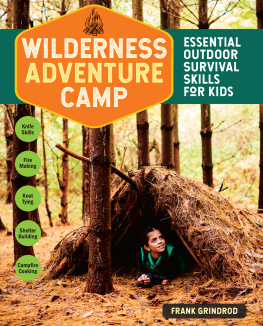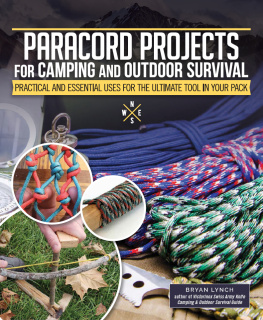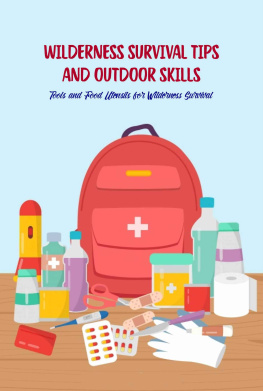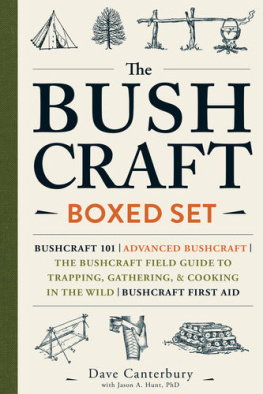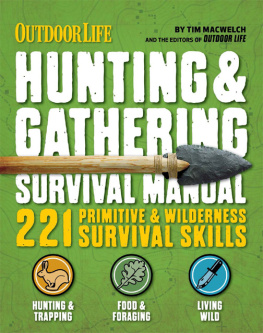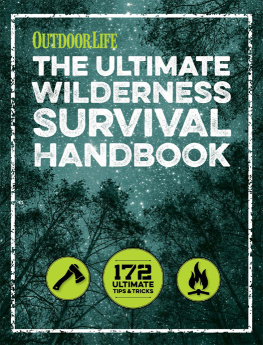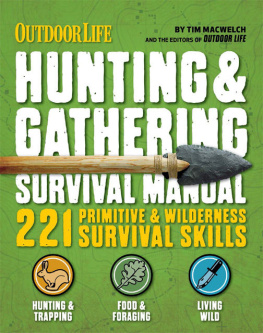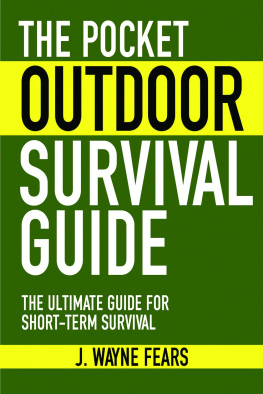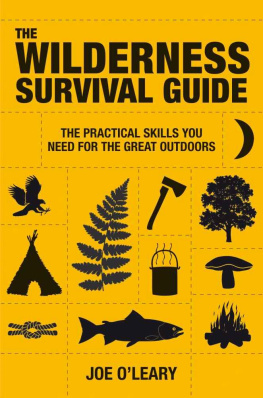SURVIVAL WISDOM & KNOW-HOW
SURVIVAL WISDOM & KNOW-HOW
Everything You Need to Know to Subsist in the Wilderness
From the Editors of Stackpole Books
Compiled by Amy Rost

Copyright 2007 Black Dog & Leventhal Publishers, Inc.
All rights reserved. No part of this book, either text or illustration, may be used or reproduced in any form without the prior written permission from the publisher.
Portions of the material contained in this work are originally published and copyrighted by
Stackpole Books and used by permission of the publisher.
Published by
Black Dog & Leventhal Publishers, Inc.
151 West 19th Street
New York, NY 10011
Distributed by
Workman Publishing Company
225 Varick Street
New York, NY 10014
Manufactured in the U.S.A.
Cover and interior design by Ohioboy Design
Cover illustration: clipart.com
ISBN-13: 978-1-57912-753-4
EISBN: 978-1-60376-273-1
Library of Congress Cataloging-in-Publication Data available on file
The publisher disclaims any responsibility for any loss, injury or damages caused as a result of any of the activities or the use of the survival techniques described in this book. Readers are advised to read and follow usage instructions included with camping and survival products that they buy. A First Aid course is essential for a well-rounded knowledge and safe use of the outdoors and this book is not intended as a substitute for techniques taught in a First Aid course. Many of the activities discuss in this book are dangerous or even life-threatening
Chapter 1 Animals and Insects
About Snow
Steps to Track Identification
Direction of Travel
Preserving Tracks
Small Rodents
Large Tree Dwellers
Rabbits and Hares
Weasel Family
Aquatic Mammals
Felines
Canines
Deer
Elk, Moose, and Caribou
Other Hooved Animals
Bears
Armadillos
Bears
Pumas
Gray wolves
Moose
Skunks
Birding: An Introduction
Basic Bird Identification
Bird Nests
Birds and Winter
Bird Tracks
Various Bird Tracks
Snake-Free Areas
Ways to Avoid a Snakebite
Snake Groups
Descriptions of Poisonous Snakes
Fish That Attack Man
The Basics of Tracking Animals
Louise R. Forrest
Illustrations by Denise Casey
Many people assume that in winter wild animals, like so many of us, escape the difficulties of traveling, feeding, and keeping warm by migrating or hibernating. This is true of cold-blooded animals and of many warm-blooded birds and mammals. However, a surprising number of birds and mammals conduct business as usual, and whenever they move, rest, feed, hunt, or behave in other ways on the ground, a record is impressed in the snow. Indeed, without the use of sophisticated equipment, snow offers one of the best opportunities to learn about the lives of animals in winter.
But why, you may ask, would anyone want to follow an animal around in the winter? Imagine a bright, sunny morning after a snow stormair crisp, snow sparklinga perfect day for a ski, a walk, or a snowmobile ride. Traveling into the woods or across the fields, you suddenly intersect a winding trail interrupting the snows smooth surface. With a little imagination, you envision the trail-maker walking, waddling, or trotting along. You follow the trail and find numerous clues that reveal this animals daily activities.
Perhaps the trail leads to the scene of a successful hunt where the two-print trail of a weasel slowed, disappeared under the snow, and then reappeared, accompanied by tiny drag marks of a hapless vole. It may lead to a spot marking the swoop of an unlucky hawk and the scurry of a luckier mouse; to a place where two coyotes met and continued on together; to a mysterious dead-end where a grouse took off in flight; to a small depression where a moose gently touched its nose to the snow to sniff for food; or to a hill that proved irresistible to sliding otters or mink. The trail itself, whether it meanders or strikes out straight ahead, reflects the behavior of the animal in motion and provides substantial amounts of biological data. More important, following it is fun! But please be aware that in winter animals are generally operating on very strict energy budgets. If you frighten them excessively or harass them, either by pursuing too closely on foot or following on a snowmobile, you may tip the scale between survival and death.
Why a book on snow-tracking when so many fine tracking books exist? During my first winter tracking efforts, I often found it difficult to match the tracks I saw in the snow with the detailed shape and toe counts of my track book illustrations. So often, snow obscured these foot details that are useful when identifying tracks in mud, sand, and sometimes in shallow snow. After several winters studying animals in the field, I decided to compile that information, gathered from my own experiences and from other track books, which proved most helpful for identifying tracks in snow.
I learned that the first rule of snow-tracking is to identify the animals track pattern, the trail left in the snow, which is often identifiable even when the tracks are windblown and obscured. Consequently, this book emphasizes track patterns, although print details are always important tracking clues whenever visible.
Mammals are the prime focus of this book because their tracks are the ones most likely to be found in winter. Tracks of birds and domestic mammals are also discussed. The North American animals included in this book are primarily those that are active in winter in areas that commonly receive snow.
About Snow
How animals have adapted to life in snow country is fascinating. Lets take a closer look at that snow environment. Snow is not just snow. Arctic natives have a surprisingly large vocabulary to describe the various forms of snow and its structure within the snowpack. While some of these variations are caused above the snow by environmental conditions like wind and cold; others, more important to many animals, are caused from below.
In areas where a persistent snow cover occurs, the temperature of the ground surface closely parallels the outside air temperature until snow cover is deeper than 6 inches. With snow cover comes an insulating blanket that retards the natural loss of the earths heat. As a result, the bottom of the snowpack becomes warmer than the top (which is exposed to cold air), and a thermal gradient is created in which heat and moisture flow upward. Snow crystals near the soil break down, and their water molecules migrate either to larger crystals or to those above.
Eventually, the bottom snow structure becomes a fragile latticework of large, coarse, granular crystals called depth hoar. This weak layer, often an underlying cause of avalanches, also provides many small animals a relatively warm, stable environment where they can easily burrow, travel, and nest while protected from the cold temperatures above. A dark, silent undersnow world is created with intricate systems of runways, tunnels, and burrows. Above, you trod along unaware of the world of activity below you! But if you are observant, you can find holes by trees or shrubs or openings near downed logs, brush piles, or rocks that are entryways to this subnivean (undersnow) world.
Of the animals that do not migrate or hibernate, only the larger ones are able to withstand extreme cold. The smaller mammals, such as shrews, voles, and mice, have such small body masses relative to their body surface area that their metabolism cannot maintain body warmth in freezing temperatures. They go below the snow where it rarely drops below 15F. Even some spiders can remain active in this environment.
Next page

